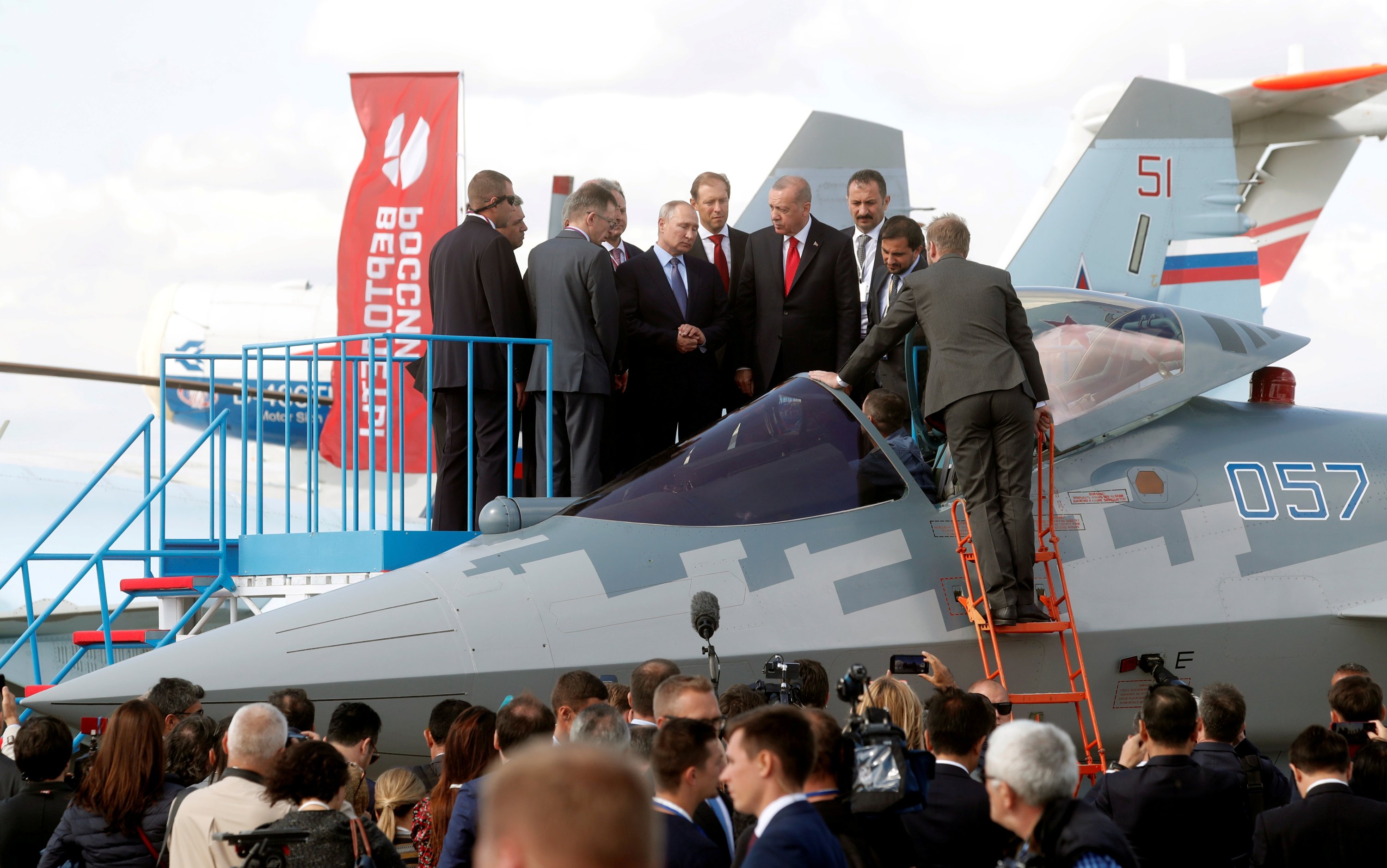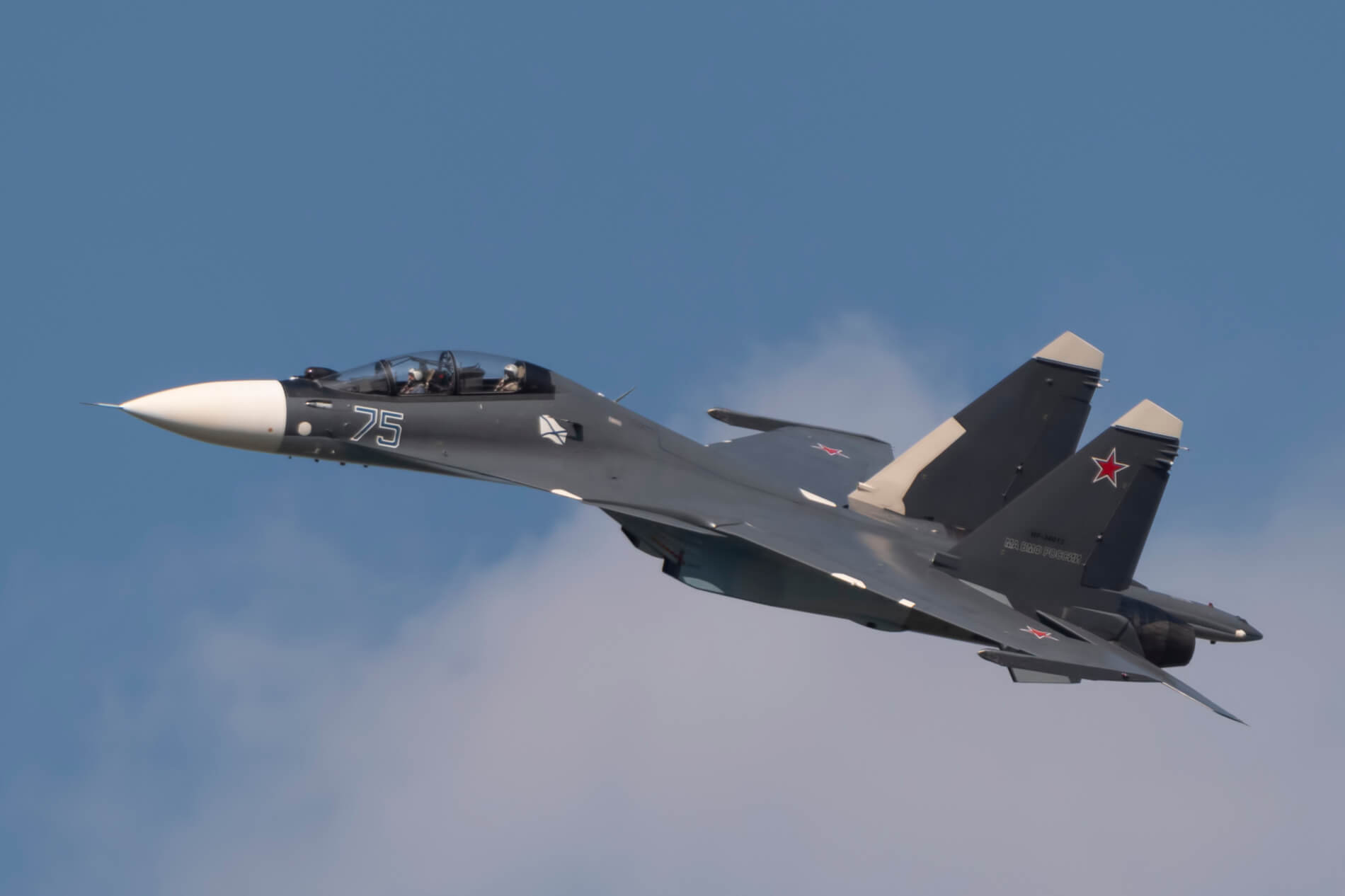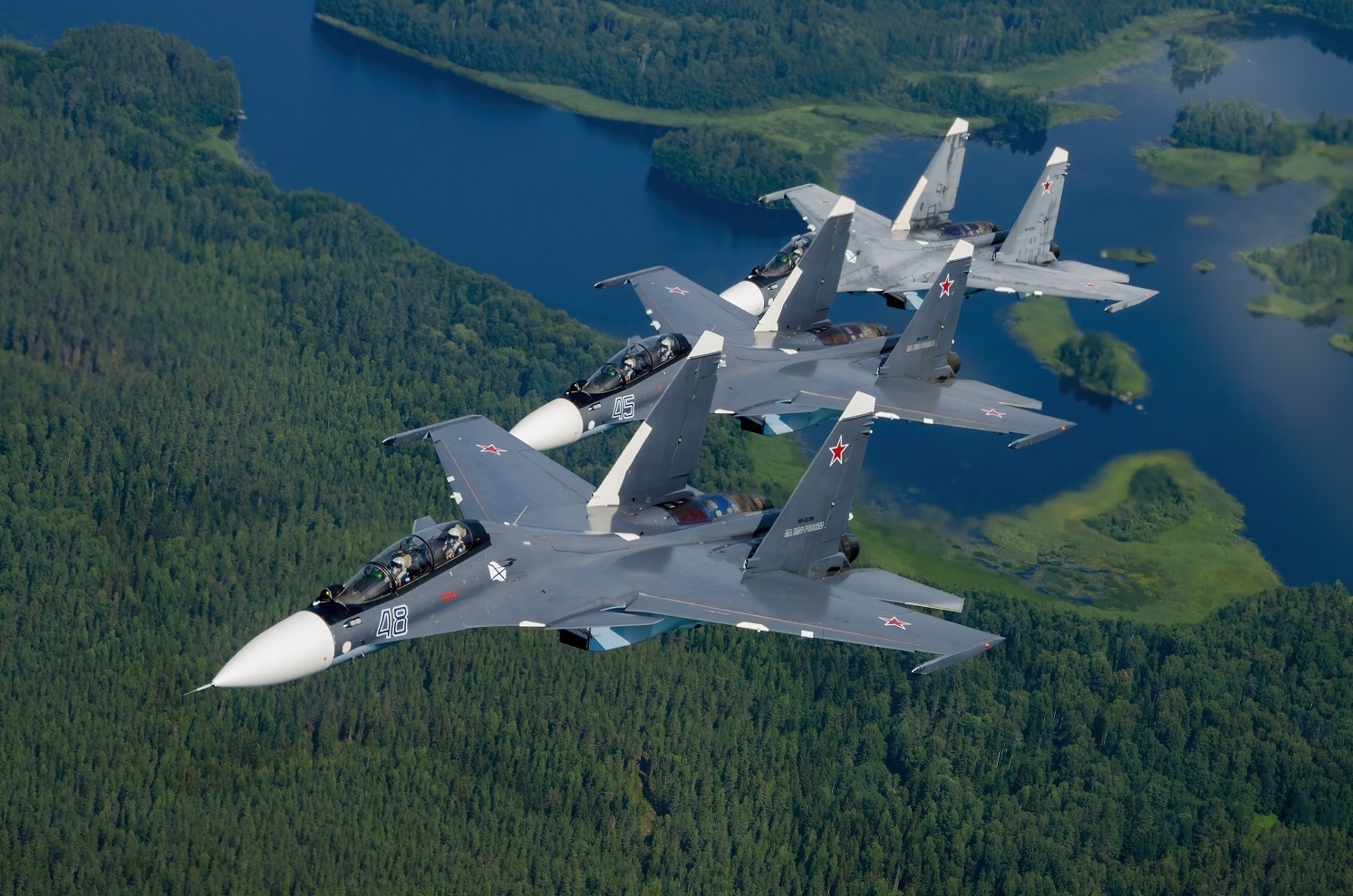Su Fighter Jets - The Sukhoi Su-27 (Russian: Сухой Су-27; NATO reporting name: Flanker) is a Soviet twin-engine supersonic aircraft designed by Sukhoi. It was introduced as a direct competitor to fourth-generation fighters such as the Grumman F-14 Tomcat and McDonnell Douglas F-15 Eagle, with a range of 3,530 kilometers (1,910 nmi), heavier aircraft, advanced avionics and navigation. superior The Su-27 is designed for high-altitude air missions, and subsequent variants are capable of almost all air warfare missions. It was designed as a complement to the Mikoyan MiG-29.
The Su-27 entered service with the Soviet Air Force in 1985. The main mission was air defense against American SAC Rockwell B-1B Lancers and Boeing B-52G and H Stratofortress bombers to protect the Soviet coast from aircraft carriers and long-range flights. Along with the fighter are some heavy bombers like Tupolev Tu-95, Tupolev Tu-22M and Tupolev Tu-160.
Su Fighter Jets

The Su-27 was developed into a family of aircraft; these include the Su-30, a two-seat, bi-wing all-weather fighter for deep air-to-air and air-to-surface interdiction missions, and the Su-33, a naval fleet defense interceptor. . air transport Other versions include the side-by-side side-seat Su-34 strike/jet-bomber variant and the improved Su-35 air superiority and multi-role fighter. The Shyang J-11 is a license-built version of the Chinese Su-27.
Russia's New Su 75 Checkmate Promises A Lot. Can It Deliver?
This section needs additional citations for confirmation. Please help improve this article by adding citations from reliable sources. Unused resources can be challenged and removed. (March 2009) (Learn how and when to remove this template message)
In 1969, the Soviet Union learned of the US Air Force's "F-X" program, which led to the creation of the F-15 Eagle. Soviet leaders quickly realized that the new American fighter would also enjoy a significant technological advantage over existing Soviet fighters. "What was needed was a more balanced fighter with good agility and advanced systems." In response, the Soviet General Staff issued a request Perspektivnyy Frontovoy Istrebitel (PFI, literally "Prospective Frontline Fighter", "Advanced Frontline Fighter").
The specifications were ambitious, calling for long range, short-field performance (including the ability to use tighter runways), maneuverability, Mach 2+ speed, and heavy armament. The aerodynamic design of the new aircraft was mainly carried out by TsAGI in cooperation with the Sukhoi design bureau.
If the definition seems challenging and expensive for the required number of aircraft, the PFI specification is divided into two: LPFI (Lyogkyi PFI, Open PFI) and TPFI (Tyazholyi PFI, Heavy PFI). The LPFI program produced the Mikoyan MiG-29, a strategic short-range fighter, while the TPFI program was assigned to the Sukhoi OKB, while producing the Su-27 and its variants.
Russia New Fighter Jet: Single Engine Stealth Fighter Details
The Sukhoi design, which was constantly modified to reflect Soviet knowledge of the F-15's specifications, was created as the T-10 (Sukhoi Design 10), which first flew on 20 May 1977. The plane had large, clipped, two-span wings. braided jeans and two tails. A "tunnel" between the two engines, as in the F-14 Tomcat, serves as additional lift and hides the weapon from radar.
The T-10 was spotted by Western observers and given the name "Flanker-A" by NATO reports. The development of the T-10 was marked by major problems, with the second prototype, the T-10-2, causing a fatal crash on July 7, 1978.
Further modifications followed (from the T-10-3 to the T-10-15) and an updated version of the T-10-7, now designated the T-10S, made its first flight on 20 April 1981. It also failed because of management. . problems and was replaced by the T-10-12, which became the T-10S-2. It also crashed on December 23, 1981 during a high-speed test, killing the pilot.

The P-42 "Streak Flanker" was stripped of all armament, radar and equipment. The wing tips, tail boom and wing tip launch rails were also removed. The composite radome was replaced with a lighter steel version. The aircraft was stripped of paint, sanded and all drags were sealed off gaps and parts. The engines were modified to increase thrust by 1,000 kg (2,200 lb), resulting in a nearly 2:1 thrust-to-weight ratio (for comparison with the standard model, see Specifications).
Russian Fighter Jet Shot Down By Ukraine Air Force In Dogfight
Production of the Su-27 (sometimes Su-27S, NATO designation 'Flanker-B') began entering VVS operational service in 1985, although production difficulties did not become apparent until the 1990s.
The Su-27 served with V-PVO and Frontal Aviation. The conversion of the operational units to the type was carried out using the Su-27UB (Russian "Uchebno Boevoy" - "Combat trainer", NATO name "Flanker-C") two-seat trainer, with the pilots sitting together.
While the Naval Flanker trainer was being created, the Soviet Air Force was testing a replacement for the Su-24 "Fcer" attack aircraft, and Soviet planners at the time saw that the role of the Su-24 should be capable. between the surviving gagemts and the new American F-15 and F-16. The Sukhoi Office is involved in the modification of the Su-27UB tandem-seat train trainer. However, the Soviet Air Force preferred the crew station (side-by-side seats) used in the Su-24, as it worked better for high operational load and long-range strike missions. Therefore, the trainer sitting next to the ships was used as the basis for the development of the Su-27IB (Russian: "Istrebityel Bombardirovshchik" - "Fighter Bomber") in 1983 as a replacement for the Su-24. It flew in early 1994 and was fitted to the Su-34 (NATO reporting name 'Fullback').
Development of the Su-27K (Russian: "Korabyelny" - "Shipborne", NATO designation "Flanker-D") for the Soviet Navy began shortly after the development of the land version. Some T10 indicators have been modified to test the sea change characteristics of carrier activity. These modified indicators led to certain Soviet Army prototypes, designated "T10K" (Korabyelny). The T10Ks featured canards, a grappling hook, and a retractable probe for carrier landing avionics and in-flight refueling. They did not have the necessary landing gear for landing gear or folding wings. The first T10K was flown in August 1987 by the famous Soviet pilot Viktor Pugachev (who had demonstrated the cobra maneuver using the Su-27 in 1989), performing a test take-off from a land-based ski-jump ship. Sea coast of Saky in the Ukrainian SSR. The plane was lost in an accident in 1988.
King Cobra' Fighter Jets Take To Hanoi Sky
At the time the Naval Flanker was being developed the Soviets were building their first generation of aircraft carriers and did not have steam catapults and did not want to delay carrier launch. Thus, it was decided to use a take-off method that did not require a catapult, building full thrust on the blast deflector until the aircraft cleared the obstacles and held the ground. The fighter will then accelerate into a back ski jump and take off into the air.
The production Su-27K had a robust set of landing gear and gear, with two wheels, stabilizers and wings, external ailerons, twin internal flaps and large wide guide slats, leading to a low-speed approach, the modified LERX. (Leading Edge Root eXtsion) fins, modified ejection seat angle, improved FBW, improved hydraulics, grab hook and retractable in-flight refueling probe and nose mounted lights to illuminate the tank at night. The Su-27K was first flown by the carrier in November 1989, again with Pugachev at the helm, on board the first Soviet aircraft carrier at the time named Tbilisi, and the commander's official operation was launched in September 1991.
Development of the Su-27KUB naval trainer (in Russian "Korabyelny Uchebno-Boyevoy" - "Shipborne Trainer-Combat") began in 1989. The aim was to create a dual role aircraft suitable for both the Navy and the Air Force. to various other engagements such as reconnection, air resupply, naval strikes and congestion. This concept came from the Su-27IB (Su-34 "Fullback") of the Soviet Air Force. The trainer had a redesigned forward fuselage with side seats and a ladder-type undercarriage, nose wheel and canards, stabilizers, wings and large rudder. The wings had additional stiffening areas and the folding area was also moved outwards. Inputs were fixed and did not show FOD for hardware restriction. The central fuselage was strengthened to carry 45 tonnes (99,000 kg) of excess weight and the interior volume was increased by 30%. The first demonstration, the T-10V-1, flew in April 1990 for air refueling tests and simulated landing in Tbilisi. The second prototype, the T-10V-2 was built in 1993 and featured large internal fuel tanks, a large rear, a long tail and a tandem of two lower wheels.

In 1991, production facilities at Komsomolsk-on-Amur Aircraft Plant and Irkutsk produced export variants of the Su-27: the Su-27SK single-seat fighter and the Su-27UBK two-seat trainer. trainer, (two K in Russian " Kommercheskiy" - literally "Commercial")
Sukhoi Su 57 Hi Res Stock Photography And Images
After the collapse of the USSR in 1991, successor state Russia began development of the main Su-27 systems including the Su-30, Su-33, Su-34, Su-35 and Su-37.
Since 1998 the Su-27SK has been manufactured under license in China as the Shyang J-11. The first license production aircraft, assembled in Shanghai from Russian-supplied kits,
Su fighter, fighter jets, su 24 fighter jets, northrop grumman fighter jets, su 35 fighter jets, metal toy fighter jets, sukhoi su 35 fighter jets, su 27 fighter jets, diecast fighter jets, sukhoi su 30 fighter jets, su 30 fighter jets, russian fighter jets su 35
0 Comments